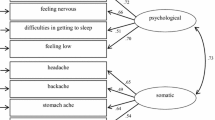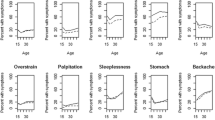Abstract
Objectives
To investigate continuity and change of self-reported physical and psychological complaints in young adults over a period of 20 years.
Study design and setting
The Zurich Study – a long-term panel survey in psychiatric epidemiology – is based on a stratified sample of 591 subjects born in 1958 (women) and 1959 (men). The sample strata combine SCL-90-R high-scorers and low-scorers in a 2:1 ratio. Up to now, the Zurich Study has included six interviews between 1979 and 1999, i.e. 20 years of life in young adults. We analysed the longitudinal frequency data of a variety of physical and psychological complaints, as well as information about subjective suffering and use of professional help. The analyses utilised on the McNemar’s test, the Q-test and Markov chain models.
Results
Sleep disorders, depression, menstruation, backache, headache, stomach and bowel complaints yielded cumulative prevalence rates of 80% or higher. Physical and psychological complaints systematically differ with respect to the change patterns between 1979 and 1999. Moreover, strong differences were found in view of subjective suffering and use of professional help.
Conclusions
Even though many self-reported physical and psychological complaints are very common in young adulthood, the underlying dynamics and the implications largely differ. It seems to be crucial whether respondents use somatic glasses or psychological lenses.




Similar content being viewed by others
Notes
For example, the two initial questions of the depression section in the 1999 interview were: (a) During the last 12 months, have you ever felt devoid of energy, depressed, sad, tired of living, or have you suffered from a loss of efficiency, feelings of inferiority, a complete lack of interests, or have you just had “the blues”? (b) Were you extremely unhappy and did not enjoy anything and even good news could not cheer you up?
References
Derogatis L (1977) SCL-90. Administration, scoring and procedures manual-1 for the R (revised) version and other instruments of the Psychopathology Rating Scale Series, Chicago
Goldberg DP, Hillier VF (1979) A scaled version of the general health questionnaire. Psychol Med 9:139–145
Pennebaker JW (2000) Psychological factors influencing the reporting of physical symptoms. In: Stone AA, Turkkan JS, Bachrach CA, Jobe JB, Kurtzman HS, Cain VS (eds) The science of self-report. Implications for research and practice. Lawrence Erlbaum Associates, Mahwah, pp 299–316
Kolk AM, Hanewald GJ, Schagen S, Gijsbers van Wijk CM (2003) A symptom perception approach to common physical symptoms. Soc Sci Med 57:2343–2354
Myrtek M (1998) Gesunde Kranke – kranke Gesunde. Hans Huber, Bern
Barsky AJ (2000) The validity of bodily symptoms in medical outpatients. In: Stone AA, Turkkan JS, Bachrach CA, Jobe JB, Kurtzman HS, Cain VS (eds) The science of self-report. Implications for research and practice. Lawrence Erlbaum Associates, Mahwah, pp 339–362
Grootendorst PV, Feeny DH, Furlong W (1997) Does it matter whom and how you ask? Inter- and intra-rater agreement in the Ontario Health Survey. J Clin Epidemiol 50:127–135
Kroenke K, Spitzer RL, Williams JB (2002) The PHQ-15: validity of a new measure for evaluating the severity of somatic symptoms. Psychosom Med 64:258–266
Knauper B, Turner PA (2003) Measuring health: improving the validity of health assessments. Qual Life Res 12(Suppl 1):81–89
Angst J, Binder J (1980) Epidemiology of depressive symptoms in a 20-year-old Swiss population. Psychiatria Fennica 65–70
Binder J, Dobler-Mikola A, Angst J (1981) An epidemiological study of minor psychiatric disturbances. A field study among 20-year-old females and males in Zürich. Soc Psychiatr 16:31–41
Angst J, Dobler-Mikola A, Binder J (1984) The Zurich Study – a prospective epidemiological study of depressive, neurotic and psychosomatic syndroms. 1. Problem, methodolgy. Eur Arch Psychiatr Neurol Sci 234:13–20
Eich D, Ajdacic-Gross V, Condrau M, Huber H, Gamma A, Angst J, Rossler W (2003) The Zurich Study: participation patterns and symptom checklist 90-R scores in six interviews, 1979–99. Acta Psychiatr Scand Suppl:11–14
American Psychiatric Association (1994) Diagnostic and statistical manual of mental disorders (DSM IV). American Psychiatric Association, Washington, DC
Bortz J, Lienert GA, Boehnke K (2000) Verteilungsfreie Methoden in der Biostatistik [Nonparametric methods in biostatistics]. Springer, Berlin
Bishop YMM, Fienberg SE, Holland PW (1975) Discrete multivariate analysis. MIT Press, Cambridge, MA
Vermunt JK (1997) lEM: a general program for the analysis of categorical data. Tilburg University
Metzger MH, Goldberg M, Chastang JF, Leclerc A, Zins M (2002) Factors associated with self-reporting of chronic health problems in the French GAZEL cohort. J Clin Epidemiol 55:48–59
Kroenke K, Spitzer RL (1998) Gender differences in the reporting of physical and somatoform symptoms. Psychosom Med 60:150–155
Hotopf M, Mayou R, Wadsworth M, Wessely S (1998) Temporal relationships between physical symptoms and psychiatric disorder. Brit J Psychiatr 173:255–261
Chen H, Guarnaccia PJ, Chung H (2003) Self-attention as a mediator of cultural influences on depression. Int J Soc Psychiatr 49:192–203
Eriksen HR, Svendsrød R, Ursin G, Ursin H (1998) Prevalence of subjective health complaints in the Nordic European countries in 1993. Eur J Public Health 8:294–298
Ladwig KH, Marten-Mittag B, Formanek B, Dammann G (2000) Gender differences of symptom reporting and medical health care utilization in the German population. Eur J Epidemiol 16:511–518
Terre L, Carlos Poston WS, Foreyt J, Jeor STS (2003) Do somatic complaints predict subsequent symptoms of depression? Psychother Psychosom 72:261–267
Ajdacic-Gross V, Graf M (2003) Bestandesaufnahme und Daten zur psychiatrischen Epidemiologie. Schweizerisches Gesundheitsobservatorium, Neuchatel
Hays RD, Stewart AL (1990) The structure of self-reported health in chronic disease patients. Psychol Assess 2:22–30
Acknowledgement
The study was supported by the Swiss National Science foundation (Grant # 32-50881.97).
Author information
Authors and Affiliations
Corresponding author
Rights and permissions
About this article
Cite this article
Ajdacic-Gross, V., Horvath, S., Canjuga, M. et al. How ubiquitous are physical and psychological complaints in young and middle adulthood?. Soc Psychiat Epidemiol 41, 881–888 (2006). https://doi.org/10.1007/s00127-006-0111-x
Accepted:
Published:
Issue Date:
DOI: https://doi.org/10.1007/s00127-006-0111-x




